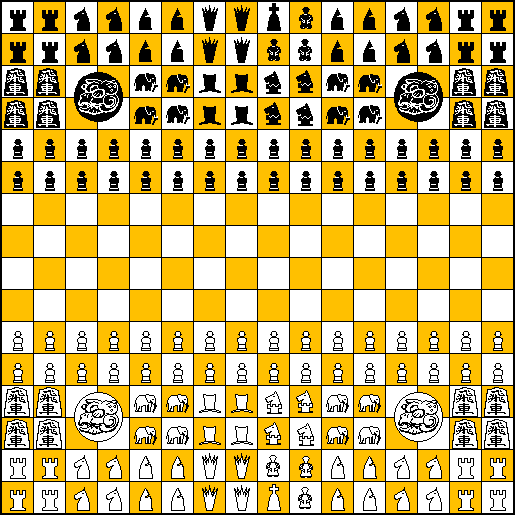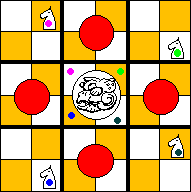Giant Chess
Giant Chess can be considered as a larger variant of Turkish Chess, with the addition of the piece Dev (=giant in Turkish). It is a really large variant (but relatively simple) and is designed for the favor of those who like more warlike games, like me.
Rules
The game is played on a 16x16 board. Each player have a King, 3 Generals, 4 Queens, 8 Bishops, 8 kNights, 8 Rooks, 4 Ministers, 4 Chancellors, 8 Elephants, 8 Shogis and 2 Devs, 32 pawns. Totaly there are 180 pieces on the board.

White: King i1; Generals i2, j1, j2; Queens g1, g2, h1, h2; Bishops: e1, e2, f1, f2, k1, k2, l1, l2; kNights: c1, c2, d1, d2, m1, m2, n1, n2; Rooks a1, a2, b1, b2, o1, o2, p1, p2; Ministers g3, g4, h3, h4; Chancellors i3, i4, j3, j4; Elephants e3, e4, f3, f4, k3, k4, l3, l4; Shogis a3, a4, b3, b4, o3, o4, p3, p4; Devs cd34, mn34; Pawns: a5, a6, b5, b6, c5, c6, d5, d6, e5, e6, f5, f6, g5, g6, h5, h6, i5, i6, j5, j6, k5, k6, l5, l6, m5, m6, n5, n6, o5, o6, p5, p6.
Black: King i16; Generals i15, j16, j15; Queens g16, g15, h16, h15; Bishops: e16, e15, f16, f15, k16, k15, l16, l15; kNights: c16, c15, d16, d15, m16, m15, n16, n15; Rooks a16, a15, b16, b15, o16, o15, p16, p15; Ministers g14, g13, h14, h13; Chancellors i14, i13, j14, j13; Elephants e14, e13, f14, f13, k14, k13, l14, l13; Shogis a14, a13, b14, b13, o14, o13, p14, p13; Devs cd1413, mn1413; Pawns: a12, a11, b12, b11, c12, c11, d12, d11, e12, e11, f12, f11, g12, g11, h12, h11, i12, i11, j12, j11, k12, k11, l12, l11, m12, m11, n12, n11, o12, o11, p12, p11.
Moves and Rules
![]() General moves and captures like the amazon, i.e. like a queen or a
knight.
General moves and captures like the amazon, i.e. like a queen or a
knight.
![]() Chancellor moves and captures like the usual chancellor, i.e. like a
rook or a knight.
Chancellor moves and captures like the usual chancellor, i.e. like a
rook or a knight.
![]() Minister moves and captures like the arcbishop, ie like a bishop or a
knight.
Minister moves and captures like the arcbishop, ie like a bishop or a
knight.
![]() Shogi moves and captures like the cannon in Xiang Qi, ie moves like a
rook and captures if there is exactly one piece of any color between its victim
vertically or horizontally.
Shogi moves and captures like the cannon in Xiang Qi, ie moves like a
rook and captures if there is exactly one piece of any color between its victim
vertically or horizontally.
![]() Elephant moves and captures like a diagonal cannon, ie moves like a
bishop and captures if there is exactly one piece of any color between its
victim diagonally.
Elephant moves and captures like a diagonal cannon, ie moves like a
bishop and captures if there is exactly one piece of any color between its
victim diagonally.
 Dev (= Giant in Turkish) stands and moves on four squares (ab12, ab34,
ab56,..., op1314, op1516). If the four squares on just next to Dev horizontally
or vertically are not occupied by one of the pieces of the same color, the
giant can move there, and capture the opponent pieces if any occurs on those
four squares. For example on an empty board, a Dev standing on cd34 can move to
any of the ab34, ef34, cd56 or cd12 four squares (see the big red dots in the
figure). Notice that Dev can never be in a four square like bc12 or ab23.
Dev (= Giant in Turkish) stands and moves on four squares (ab12, ab34,
ab56,..., op1314, op1516). If the four squares on just next to Dev horizontally
or vertically are not occupied by one of the pieces of the same color, the
giant can move there, and capture the opponent pieces if any occurs on those
four squares. For example on an empty board, a Dev standing on cd34 can move to
any of the ab34, ef34, cd56 or cd12 four squares (see the big red dots in the
figure). Notice that Dev can never be in a four square like bc12 or ab23.
Devs can capture devs directly. However the other pieces of the opponent can
capture the dev, if all of the four squares that dev is standing on are under
threat of a piece of the opponent. For example a dev standing on cd34 can
becaptured by any of the two queens standing on d2 and c5, because the queen on
d2 threatens c3 and d3 and the other queen threatens c4 and d4. So, for
example, the queen on d2 can come to c3 or d3 and capture the dev (see the
figure for another example with knights, any of the knights can capture the
Dev.).
King, queen,bishops, knights,rooks have exactly the same rules as in FIDE chess. Castling can be done with rooks just as in orthodox chess.
Pawns move just as in FIDE chess. Any white pawn on rows 5, 6 or any black pawn on rows 11, 12 can make an initial double step move. En passant exists with the same rule (ie if one of the opponent's pawns make a double step move, and comes just next to one of your pawns, you can capture that pawn by en passant). Pawns promote when they reach the last two rows (1, 2 or 15, 16) of the board, to any non-pawn, non-king piece. If they promote to a Dev, the giant is put to the appropriate four squares.
Other Rules
White begins the game. The aim is to checkmate the opponent's king as usual. Stalemate is considered just the same as in orthodox chess.
Note: A quicker variant can also be played in which each side makes four moves a time. A check should be given not before the 4th move, otherwise the turn passes to the other player.
(c) Köksal Karakus - 2000
Written by Köksal Karakus.
WWW page created: February 7, 2000.